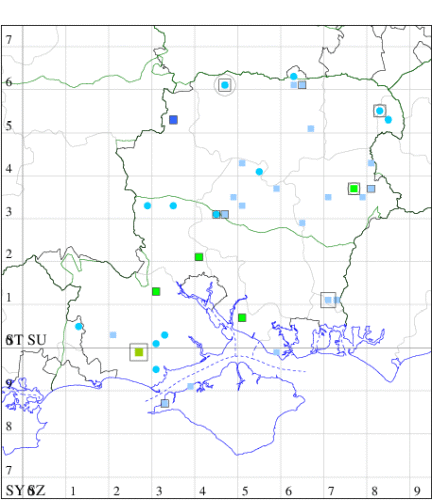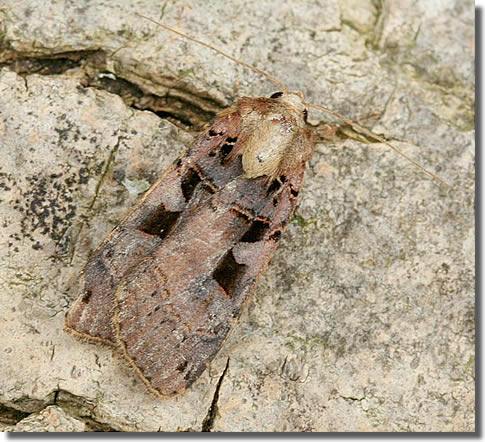Triple-spotted Clay
Xestia ditrapezium
Checklist Number73.360 [B&F: 2127]
Verification
Record requires retention of specimen until confirmed, and may require dissection. Consult with CMR if unsure
Local, in damp, broad-leaved woodland and fens, from Kent and East Anglia to Devon, in Wales and in central and west Scotland. In Hampshire and on the Isle of Wight it is very rare, with only three records since 1989, the last being at Shortheath Common in 2008. Wingspan 39-46mm. Pattern very similar to that of Double Square-spot X. triangulum, but the colour of the forewing is a more intense, redder brown, more heavily suffused with fuscous, and the hindwing is relatively paler (MBGBI Vol 9). A specimen of this species must be retained for the record to be considered for acceptance. A photograph is NOT considered sufficient for the purpose. In autumn, larva feeds on herbaceous plants such as Primrose, Dandelion and Dock, and in spring on buds of Sallow, Dogwood and other woody plants.


The abundance in each month is indicated as follows:
 No records
No records Very occasional
Very occasional Irregular
Irregular Uncommon
Uncommon Off-peak, but not unusual
Off-peak, but not unusual Off-peak, but not unusual
Off-peak, but not unusual Main flight time
Main flight time| J | F | M | A | M | J | J | A | S | O | N | D | |
|---|---|---|---|---|---|---|---|---|---|---|---|---|
| Adult |  |  |  |  |  |  |  |  |  |  |  |  |
| Larval |  |  |  |  |  |  |  |  |  |  |  |  |
Records by week (adult)
Records by week (larval)
VC8 Wiltshire (Hants county)
| Site | Date | Quantity | Recorder | Stage |
|---|---|---|---|---|
| Canada Common (SU21) | 21/07/2022 | one | Colin Easton | Adult |
VC10 Isle of Wight
| Site | Date | Quantity | Recorder | Stage |
|---|---|---|---|---|
| Freshwater (SZ38) | 01/08/1968 | one | Sam Knill-Jones | Adult |
VC11 South Hampshire
| Site | Date | Quantity | Recorder | Stage |
|---|---|---|---|---|
| Havant Thicket (SU71) | 17/07/1959 | three | B Goater, MW Harper, J Higgins | Adult |
| Winchester (SU43) | 02/07/1975 | one | D H Sterling | Adult |
| Roydon Woods HIWWT NR, NF (SU30) | 1981 | - | Tony Pickles | - |
| Perrywood Ironshill Inclosure (SU30) | 01/07/1981 | - | Brian Elliott | - |
| Yew Hill NR (SU33) | 06/07/1984 | - | Wayne Borras | Adult |
| Ringwood (SU10) | 14/07/1987 | - | Julian Clarke | Adult |
| Broughton Down (SU23) | 14/07/1989 | - | Tony Pickles | Adult |
| Locks Heath (SU50) | 10/05/2001 | one | Peter Carr | Adult |
| Chandlers Ford (SU42) | 26/07/2001 | one | Brian Elliott | Adult |
| Cadnam (SU31) | 21/07/2006 | one | Maurice Pugh | Adult |
| Sway (SZ29) | 23/06/2014 | four | Steve Keen | Adult |
VC12 North Hampshire
| Site | Date | Quantity | Recorder | Stage |
|---|---|---|---|---|
| Abbotstone Down (SU53) | 1961 | - | Anon | - |
| Lindford (SU83) | 1970 | one | J W O Holmes | Adult |
| Bramley Frith (SU66) | 1979 | one | Tony Dobson | Adult |
| Northwood (SU43) | 1980 | one | Reg A Bell | Adult |
| Burghclere (SU46) | 1984 | two | GGE-F | Adult |
| Fleet Pond (SU85) | 1987 | - | W Kittle | - |
| Fleet Pond (SU85) | 1988 | two | Graham Stephenson | Adult |
| Wildhern (SU35) | 22/07/1996 | one | David G Green | Adult |
| Shortheath Common, Oakhanger (SU73) | 07/07/2008 | one | Tony Davis | Adult |
| Shortheath Common, Oakhanger (SU73) | 07/07/2008 | one | Tony Davis | Adult |

